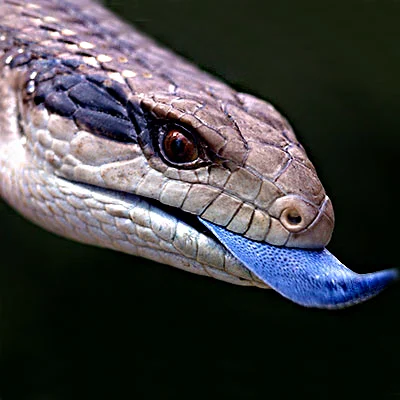Blue-tongued Lizard (Blue Tongued Skink)
Contents
The Blue-tongued lizard, also known as the blue-tongued skink, is famous for its large bright blue tongue, which it sticks out to scare off predators. It is a stout, slow-moving reptile with a cylindrical body, smooth, scaled skin, short stumpy legs, and long tail.
The Blue-tongued lizard is the largest member of the skink family. In the USA, where this Australian lizard is a popular pet, it is often called the Blue Tongued Skink—which is actually its correct colloquial name. Its scientific name is Tiliqua scincoides scincoides.
Blue Tongued Lizard Description
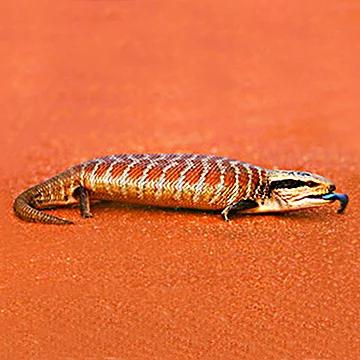
What Do Blue-Tongued Lizards Look Like?
Blue-tongued lizards range from 21cm (8in) to 60cm (24in) in length and weigh 283-510g (10-18oz).
Their body colours vary by species.
• Eastern Blue tongue is usually grey with brown stripes across its back and tail.
• Shingleback (Stumpy-Tailed Lizard) is dark brown and has a shorter stumpy tail.
Unique Defence Mechanism
The blue-tongued lizard is known for its unique defence strategy:
• When threatened, it puffs up its body, hisses, opens its large pink mouth and sticks out its bright blue tongue to intimidate predators.
• It will flatten its body, if necessary, to appear larger and less palatable to its adversary.
• It has a sacrificial tail, meaning that if caught by a predator, it can detach its tail and later regrow a shorter version.
Cold-Blooded Behaviour
The blue-tongued lizard is cold-blooded and starts its day by basking in the sun to warm up. During winter it enters a state of 'brumation' where it conserves energy by slowing its metabolism considerably, a process similar to hibernation in mammals.
Blue Tongued Lizards are Not Dangerous
Blue-tongued lizards quickly get used to the presence of humans and are harmless unless provoked, in which case they may bite—but the damage is minimal.
Where Do the Blue Tongued Lizards Live?

Photo: Blue-tongued Skink Habitat
Blue-tongued lizards live in grasslands, woodlands, and forests in Australia, New Guinea, and Indonesia.
They prefer environments with ample hiding spots, such as logs, tall grass, and leaf litter. They are territorial, living in fixed areas and rarely leaving their home range. At night, they seek shelter under logs, rocks, or inside burrows abandoned by other animals.
What Do Blue Tongued Lizards Eat?
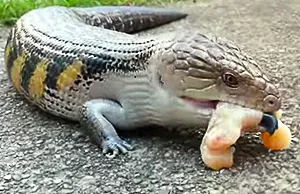
Photo: Blue-tongued Skink feeding
Blue-tongued lizards are omnivores that primarily forage for food by scavenging for insects, snails, slugs, baby snakes, fruits, and berries. They rely on their eyesight and a unique adaptation called Jacobson’s Organ, located on the roof of their mouth, to help detect their prey. With strong jaws designed to crush hard-shelled creatures like beetles and snails, these lizards do not need to chew their food; instead, they simply chomp down and swallow their meals whole. Additionally, blue-tongued lizards store excess fat and water in their tails, so losing their tail during times of scarcity can lead to starvation and death.
Blue Tongued Lizard Reproduction
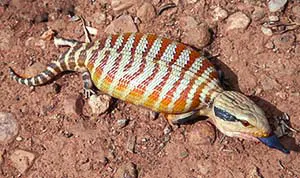
Photo: Pregnant Blue-tongued Skink
Blue-tongued lizards mate between September and November, during which time male blue-tongued lizards compete for the opportunity to mate with a female. Unlike most lizard species, female blue-tongued lizards give birth to live young instead of laying eggs. They can have up to ten baby lizards, which are fully functional and independent right after birth. It takes about three years for a blue-tongued lizard to reach adulthood, and they can live for up to twenty years.
What Kills Blue Tongued Lizards?
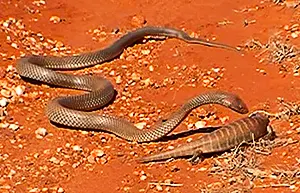
Photo: Blue-tongued Skink attacked by a snake
The blue-tongued lizard predators include dingoes, kookaburras, snakes, foxes, and dogs. Feral cats are one of its most ferocious predators.
Many blue-tongued lizards are accidentally run over by lawnmowers or cars. Additionally, poison bait used to exterminate snails and slugs can be fatal when ingested by the lizard.
Is the Blue Tongued Lizard Endangered?
Most species of blue-tongued lizards are common throughout Australia. However, the Pygmy, Western Blue Tongued and Central Blue Tongued lizards are classified as vulnerable.
It is illegal to capture a wild blue-tongued lizard. But it is legal to purchase a pet lizard from a pet shop.
25 Blue-Tongued Lizard Facts
- The blue-tongued lizard is a fat, slow-moving lizard with short stumpy legs.
- It opens its mouth and displays a large, fleshy blue-tongued to scare off predators.
- It lives throughout Australia and is frequently found in suburban gardens.
- The blue-tongued lizard is about 30cm long, with a large triangular head.
- It has a silvery grey to brown body with smooth scales with dark stripes running across its body and tail.
- Its underbelly is usually a light grey.
- If grabbed by the tail, it may shed its tail in an attempt to escape.
- It stores fat and water in its tail. The loss of its tail can lead to its death by starvation.
- The blue-tongued lizard is omnivorous --It will eat almost anything.
- It forages for its food and doesn't actively hunt for prey.
- Its diet consists of insects, snails, slugs, baby snakes, fruits, berries, etc.
- Besides its nose, the blue tongue lizard has a special organ, called a ‘Jacobson's Organ', on the roof of its mouth that can detect chemicals emitted by its prey.
- It has many small teeth and a powerful bite.
- The bite isn't painful to humans but can easily crunch its prey.
- Unlike most lizards, the blue-tongued lizard doesn't lay eggs.
- It gives birth to live babies.
- The young lizards are fully independent from birth.
- The Blue-tongue lizard is territorial, living in a fixed area all its life.
- It is a solitary animal that prefers to live on its own.
- They can live for 25-30 years.
- It is illegal to catch or kill a blue-tongued lizard.
- But they can be bought from a pet-shop and kept as pets.
- Humans accidentally run over many blue-tongued lizards with their cars and lawnmowers.
- The pygmy blue-tongued lizard is endangered.
- It is the world's largest skink.
All Rights Reserved. (Last Updated: May 27, 2025)
